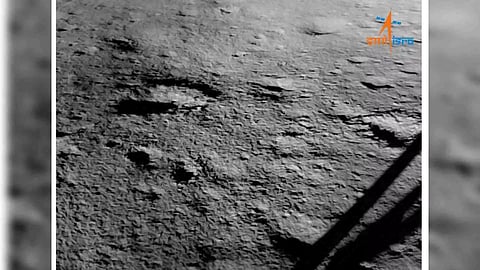

As ISRO’s ambitious third Moon mission, the Chandrayaan-3’s Lander Module (LM) touched down on the lunar surface on Wednesday, India erupted in jubilation, having scripted history. The achievement of landing a robotic lunar rover in ISRO’s second attempt in four years, makes India only the fourth country to master the technology of soft-landing on the lunar surface after the US, China and the erstwhile Soviet Union. India is also the very first nation to reach the uncharted south pole of Earth’s only natural satellite. It might be recalled that the Rs 600 crore Chandrayaan-3 is a follow-on mission to Chandrayaan-2 and its objectives are to demonstrate safe and soft-landing on the lunar surface, roving on the Moon, and to conduct in-situ scientific experiments.
The stakes are significantly high when one considers that the Chandrayaan-2 had failed in its lunar phase when its lander ‘Vikram’ crashed into the surface of the Moon minutes before touchdown in September 2019. Chandrayaan-3’s soft-landing was also attempted just days after Russia’s Luna-25 spacecraft crashed into the Moon after spinning out of control.
The moon landing is a red letter day for India and heralds a new chapter in our history of space exploration. It is also a time for the government to address a few shortcomings that have plagued our top scientists for decades together. For starters, the space agency is lauded for employing the Indian model of jugaad or frugal engineering to achieve its objectives. The reason is the paltry sums earmarked for space exploration and research in India. The budget as per 2023-2024 set aside a sum of Rs 12,544 crore ($1.5 billion) for government space activities, which is 8% lower than what was budgeted for in 2022-2023. The year before, in 2021-22, the sum set aside was Rs 12,474 crore. One can see that these increments of under Rs 100 cr in annual budgets is not what we should be promising the stalwarts helming our space programme.
To put this into context, it is necessary to consider the budgets expended by our closest rivals in the space race. In FY 2023, National Aeronautics and Space Administration (NASA) had $32.41 billion distributed among its sub-components (which is 30 times as much as that of India). On the other end of the spectrum is the China National Space Administration (CNSA) which is armed with a budget of $11.94 billion (ten times as much as India). But ISRO outperforms its peers working on wafer thin allocations. The Centre must intervene as budgets must start allocating more practical sums towards space research.
India’s contribution to the global space economy is just 2%. And we are harbouring ambitions pertaining of setting up a space station by the year 2030 and a manned moon mission in 2024. This requires massive investments, not just from the Centre, but from the private sector as well. The moon-landing is a shot in the arm for space start-ups, and it is time for States to begin crafting policies offering tax holidays and subsidies to companies working in the space and satellite verticals (just like the Centre’s PLI rollout for the semiconductor industry). ISRO will need a new generation to succeed its talent pool, which will require academicians to stop churning out managers, coders and aggregators. The next batch of pass-outs must include researchers and spacefarers with an interstellar aptitude.